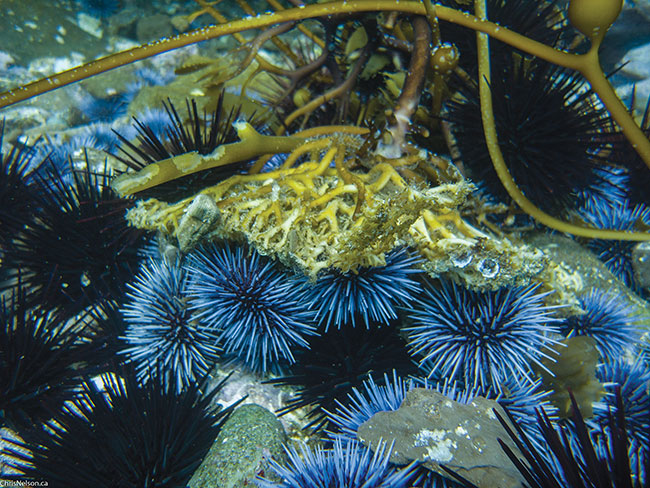
Kelp forests fight for survival against marauding sea urchins
April 4, 2023
By Julia Hollister
 Photo: Chris Nelson
Photo: Chris Nelson Sea urchins seem to have opposing roles in the earth’s playbook: it is a delicious delicacy on the menu at popular seafood restaurants and dangerous, deadly predators of kelp forests.
Denise Macdonald is with Urchnomics.com, a company that was founded in Norway in 2014 with the goal of studying the sea urchins. It was a vision of founder Brian Tsuyoshi Takeda.
There are many studies going on all the time on sea urchins at multiple universities and government institutions around the world. When the company opened in California, scientists worked with San Diego State University and University of California-Davis on testing, and among other things – the viability of ranching purple urchins.
“The resilience of our kelp forests is under strain in many parts of the world due to the release of unprecedented amounts of carbon into our air and sea,” said Takeda. “This is due to the cumulative impact of global warming, ocean acidification, combined with over fishing.”
“All these factors have created the perfect conditions for the humble sea urchin to reproduce unhindered, to overgraze on the kelp forests and transforming this habitat into a near lifeless, empty, barren desert void of shelter and breeding grounds for fish.”
No kelp means no fish, no carbon sequestration and no jobs.
Urchins don’t like small fish on their daily menu. They feed on algae and kelp, but they can live dormant for decades with very little nutrients. These are the barren urchins and the ones that Urchinomics’ study include.
The purple urchin is a species of urchin. “Barren” just refers to the fact that they are in starvation mode. So, all species can have barren urchins. These barren urchins are often located in urchin barrens where the kelp has been over grazed.
“The urchins’ munching on kelp has not always been a threat,” Macdonald said. “But, because of overfishing, pollution and climate change, they have multiplied at a staggering rate in parts of the world and caused an imbalance in the ecosystem.”
Macdonald said the sea urchin population increased massively over the last five years.
Advertisement
Sea urchins have always been predators of kelp. Macdonald said there are too many urchins in oceans now to keep the ecosystem balanced and their predators know the difference between barren urchins and urchins that contain roe.
Luke Gardner, aquaculture specialist, California Sea Grant, Research Faculty, Moss Landing (Calif.) Marine Laboratories covers a myriad of sea urchin studies.
“I started studying sea urchins in 2019 as a class project for an aquaculture course I was teaching at Moss Landing Marine Labs,” he said. “It was an interesting project to introduce and engage students in the concept of urchin ranching that joins different interest groups together, including commercial divers, aquaculture operators, and environmental groups with a common goal to help restore endangered kelp forests.”
There are lots of different urchin studies underway concerning the ecology and size of the issue. In terms of aquaculture, there are a number of studies investigating the feasibility of the ranching practice generally. Specifically, this concept is trying to find a diet that generates gonads of suitable quality, this includes taste, colour and texture.
Also, there are studies to understand the husbandry conditions necessary for their culture, including how to control their reproductive cycle to stop the species going into game-to-genesis. Active game-to-genesis reduces the quality of the gonads for market. Studies are also underway to investigate and look at the economic feasibility of urchin ranching.
Gardner said he doesn’t put sea urchins in the predator category, but eating kelp has always been a threat.
“Last I heard, the population was up 10,000 percent on normal levels,” he said. “I’m not sure the population is still increasing or not, because, as the urchins eat all the kelp, there is nothing left for them to use, and reproduction becomes difficult. Urchins, however, don’t seem to readily die after they eat all the kelp and seem to persist in a dormant state or on very little nutrients.”
“I wouldn’t really call sea urchins predators, they are more grazers but will also eat just about anything if given the chance. Urchins don’t eat all small fish species, but they will eat dead fish.”
Ordinarily, urchins eating kelp is part of a balanced ecosystem and isn’t an issue. But with changes in the system, including a mass die off of a major urchin predator (sunflower sea stars from wasting disease) their numbers flourished. This also coincided with an unusual warm period in the ocean water of the surrounding region. The kelp species needs colder temperature to reproduce, and so, that was a double whammy being that kelp didn’t reproduce well during that time and the main predator of the urchins was absent.
But there is tasty news about the urchin’s rising popularity in the culinary sector. It is usually called ‘uni’, and is actually a delicacy in many parts of the world. It’s known for a creamy, buttery flavour and is usually eaten right out of the shell.
Kevin Sancimino with Swam Oyster Depot in San Francisco said most of the tastiest urchins come from the north coast of California.
“We like to run them through a water rinse and sell them live,” he said. “This results in a clean, stronger taste.
“But, eating live sea urchins is similar to an observation by Forrest Gump in the movie: It’s like a box of chocolates, you never know what you are getting.”





